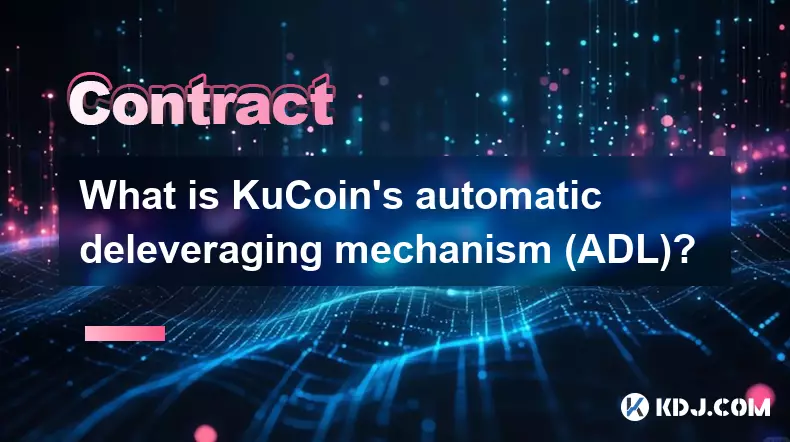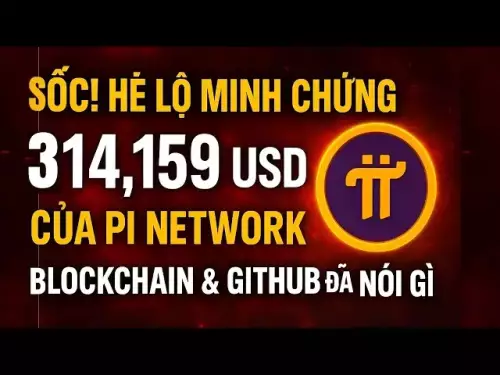-
 bitcoin
bitcoin $109547.008142 USD
0.04% -
 ethereum
ethereum $4011.838726 USD
-0.05% -
 tether
tether $1.000402 USD
-0.01% -
 xrp
xrp $2.798606 USD
0.88% -
 bnb
bnb $970.877944 USD
1.39% -
 solana
solana $202.237275 USD
-0.95% -
 usd-coin
usd-coin $0.999673 USD
0.00% -
 dogecoin
dogecoin $0.229294 USD
-1.15% -
 tron
tron $0.336370 USD
-0.45% -
 cardano
cardano $0.777260 USD
-1.66% -
 hyperliquid
hyperliquid $45.503019 USD
1.73% -
 ethena-usde
ethena-usde $1.000362 USD
0.01% -
 chainlink
chainlink $20.785303 USD
-1.10% -
 avalanche
avalanche $28.755822 USD
-0.11% -
 stellar
stellar $0.358303 USD
-0.48%
What is KuCoin's automatic deleveraging mechanism (ADL)?
KuCoin's ADL system protects market stability by automatically reducing high-leverage, profitable opposing positions when liquidations fail to cover losses.
Sep 21, 2025 at 07:00 am

Understanding KuCoin's Automatic Deleveraging Mechanism (ADL)
1. The automatic deleveraging mechanism on KuCoin is designed to manage the risks associated with leveraged trading, particularly in futures markets. When traders open positions using high leverage, there’s an increased chance of liquidation if market movements go against their positions. In extreme volatility, even after liquidation, the system may face difficulties recovering losses from deeply underwater positions, especially in isolated margin modes.
2. To maintain platform stability and protect the overall health of the futures market, KuCoin implements ADL as a last-resort risk control tool. Unlike traditional insurance funds that cover residual losses, ADL directly offsets losing positions by reducing profitable counterparties’ positions in reverse order of their leverage and profitability. This ensures that the system remains solvent without relying solely on external funds.
3. The mechanism activates when a trader’s position gets liquidated and the available collateral isn’t sufficient to cover the deficit. Instead of passing this loss onto the exchange or other unrelated users, KuCoin identifies opposing traders who are in profit and have high leverage ratios. These traders are then partially or fully closed out based on a tiered ranking system.
How ADL Prioritizes Counterparty Positions
1. KuCoin uses a specific hierarchy to determine which profitable positions are reduced during an ADL event. The primary factor is the leverage level used by the counterparty. Traders who utilize higher leverage are ranked higher in the ADL queue because they represent greater systemic risk. A position opened with 50x leverage will be targeted before one using 10x leverage, assuming both are profitable and on the opposite side.
2. Profitability also plays a crucial role. The more unrealized profit a position holds, the more likely it is to absorb part of the loss through deleveraging. However, only those in net profit are eligible for reduction. This protects traders whose positions, while highly leveraged, are currently at a loss or barely breaking even.
3. The system continuously updates the ADL ranking list in real time. This transparency allows traders to monitor their current standing and adjust their strategies accordingly. Users can access the ADL level indicator on the trading interface, which shows how close they are to being impacted should a cascade of liquidations occur.
Impact of ADL on Traders
1. For traders on the receiving end of ADL, the experience involves an involuntary closure of part or all of their position without prior warning. Since this occurs during periods of extreme market stress, price slippage and rapid volatility often accompany the event. Affected traders lose exposure despite being on the correct side of the trade.
2. One major implication is that high-leverage strategies, while potentially rewarding, expose traders to indirect risks beyond simple liquidation. Even with proper stop-loss placement and positive PnL, being over-leveraged can result in forced exit via ADL when others in the market collapse.
3. Traders can mitigate ADL exposure by reducing leverage, securing profits early, and avoiding maximum leverage settings. Monitoring the ADL queue provides situational awareness, allowing proactive adjustments before entering volatile markets.
4. From a market integrity perspective, ADL prevents cascading insolvencies. Without such a mechanism, widespread liquidations could lead to negative equity scenarios where the exchange must absorb losses, potentially affecting withdrawal capabilities or trust in the platform.
Risk Management and Transparency Features
1. KuCoin provides tools like the ADL ranking display and risk limit levels to help users understand their vulnerability. Each contract tier corresponds to different levels of allowable leverage and associated ADL priority, giving structure to risk exposure.
2. Position tiers increase with size, and each tier comes with progressively lower maximum leverage. This design discourages excessively large, over-leveraged bets that could threaten system stability during sharp reversals.
3. Real-time notifications and dashboard indicators allow traders to see when they’re approaching higher-risk categories. Adjusting position size or leverage resets the risk profile and moves the user down the ADL ladder.
4. Transparency in the triggering conditions helps build trust, as users can verify why and when deleveraging occurred. Historical data on past ADL events is sometimes made available, enabling analysis of frequency and impact under various market conditions.
Frequently Asked Questions
What triggers an ADL event on KuCoin?An ADL event is triggered when a leveraged position is liquidated and the remaining collateral cannot cover the loss, requiring offsetting actions against profitable, highly leveraged opposite-side positions.
Can I avoid being affected by ADL?Yes, by using lower leverage, managing position size within lower risk tiers, and staying aware of your rank in the ADL queue, you can significantly reduce the chances of being impacted.
Does ADL happen frequently?ADL events are rare and typically occur during periods of extreme market volatility, such as flash crashes or sudden breakouts, where multiple high-leverage positions get liquidated simultaneously.
Is ADL unique to KuCoin?While the exact implementation varies, several major derivatives exchanges use similar automatic deleveraging systems, including FTX (historically), Bybit, and BitMEX, to maintain market solvency during crises.
Disclaimer:info@kdj.com
The information provided is not trading advice. kdj.com does not assume any responsibility for any investments made based on the information provided in this article. Cryptocurrencies are highly volatile and it is highly recommended that you invest with caution after thorough research!
If you believe that the content used on this website infringes your copyright, please contact us immediately (info@kdj.com) and we will delete it promptly.
- XRP, Bitcoin Price Predictions: Decoding the Crypto Crossroads
- 2025-09-28 08:25:12
- ChatGPT, Crypto, and Crystal Balls: Predictions for a Wild 2025
- 2025-09-28 08:45:12
- Crypto Clash: Can Kaspa and Pi Coin Compete in a Remittix World?
- 2025-09-28 08:45:12
- Riding the Floki Wave: Gauging Gains with Social Engagement and Bottom Signals
- 2025-09-28 08:25:12
- Bitcoin's $109,000 Support: Will It Hold or Fold?
- 2025-09-28 09:05:14
- Crypto 2025: MoonBull Charges Ahead, Leaving Pepe and Mog in the Dust
- 2025-09-28 08:50:12
Related knowledge

How do I enable the "scalping-only" mode for Cardano (ADA) contracts?
Sep 24,2025 at 03:19am
Understanding Scalping Strategies in Crypto Derivatives1. Scalping in cryptocurrency trading refers to executing multiple short-term trades within min...

What is the settlement time for Cardano (ADA) contracts?
Sep 28,2025 at 04:18am
Understanding Cardano's Contract Settlement Mechanism1. Cardano operates on a proof-of-stake consensus model known as Ouroboros, which fundamentally i...

How do I add margin to Cardano (ADA) contracts?
Sep 27,2025 at 07:54pm
Understanding Margin in Cardano (ADA) Smart ContractsCardano operates on a proof-of-stake blockchain that supports smart contracts through its Plutus ...

What is the maximum position limit for Cardano (ADA) contracts?
Sep 23,2025 at 11:00pm
Understanding ADA Futures and Derivatives Market Structure1. Cardano (ADA) futures contracts are offered by several major cryptocurrency derivatives e...

What is the maker fee for Cardano (ADA) contracts?
Sep 26,2025 at 09:01am
Understanding Maker Fees in Cardano (ADA) Contracts1. The concept of maker fees applies broadly across decentralized exchanges and smart contract plat...

How can I view open interest in Cardano (ADA) contracts?
Sep 24,2025 at 07:36am
Understanding Open Interest in Cardano Derivatives1. Open interest refers to the total number of outstanding derivative contracts, such as futures or ...

How do I enable the "scalping-only" mode for Cardano (ADA) contracts?
Sep 24,2025 at 03:19am
Understanding Scalping Strategies in Crypto Derivatives1. Scalping in cryptocurrency trading refers to executing multiple short-term trades within min...

What is the settlement time for Cardano (ADA) contracts?
Sep 28,2025 at 04:18am
Understanding Cardano's Contract Settlement Mechanism1. Cardano operates on a proof-of-stake consensus model known as Ouroboros, which fundamentally i...

How do I add margin to Cardano (ADA) contracts?
Sep 27,2025 at 07:54pm
Understanding Margin in Cardano (ADA) Smart ContractsCardano operates on a proof-of-stake blockchain that supports smart contracts through its Plutus ...

What is the maximum position limit for Cardano (ADA) contracts?
Sep 23,2025 at 11:00pm
Understanding ADA Futures and Derivatives Market Structure1. Cardano (ADA) futures contracts are offered by several major cryptocurrency derivatives e...

What is the maker fee for Cardano (ADA) contracts?
Sep 26,2025 at 09:01am
Understanding Maker Fees in Cardano (ADA) Contracts1. The concept of maker fees applies broadly across decentralized exchanges and smart contract plat...

How can I view open interest in Cardano (ADA) contracts?
Sep 24,2025 at 07:36am
Understanding Open Interest in Cardano Derivatives1. Open interest refers to the total number of outstanding derivative contracts, such as futures or ...
See all articles










































































